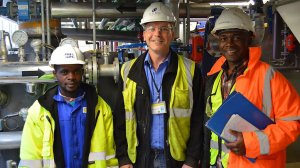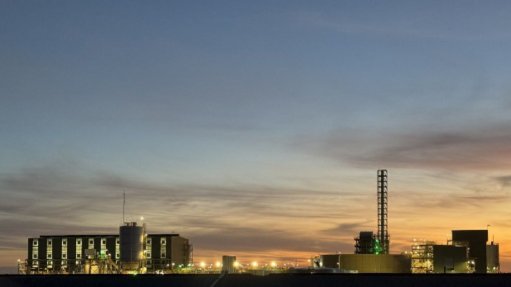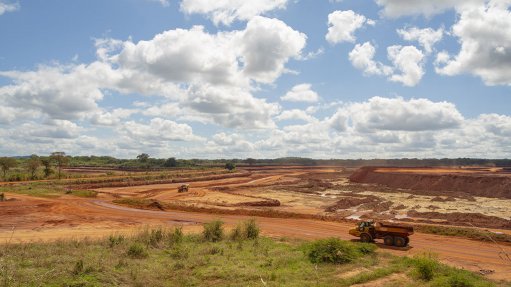SA and Australia firms team up to serve African gold mining


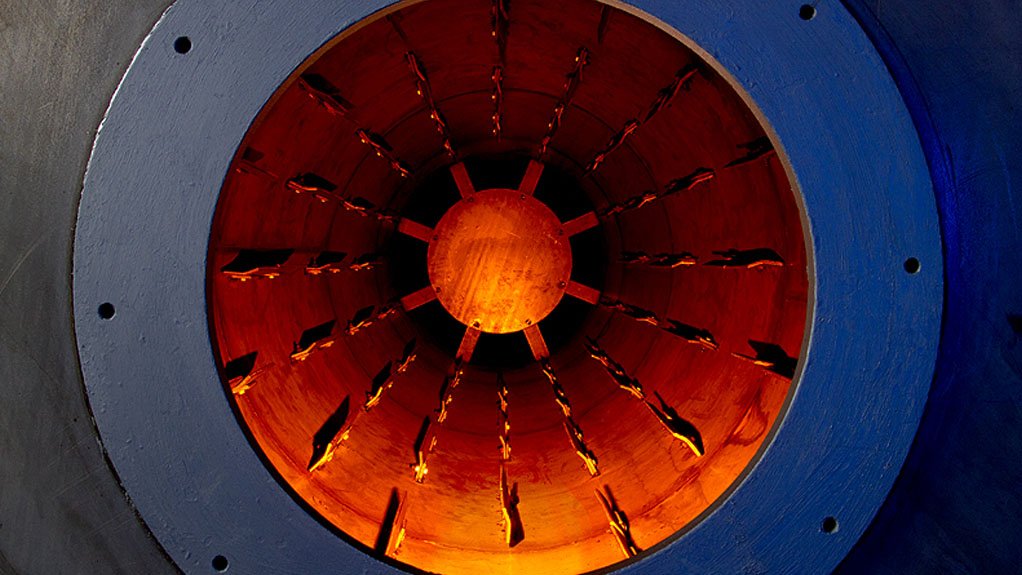
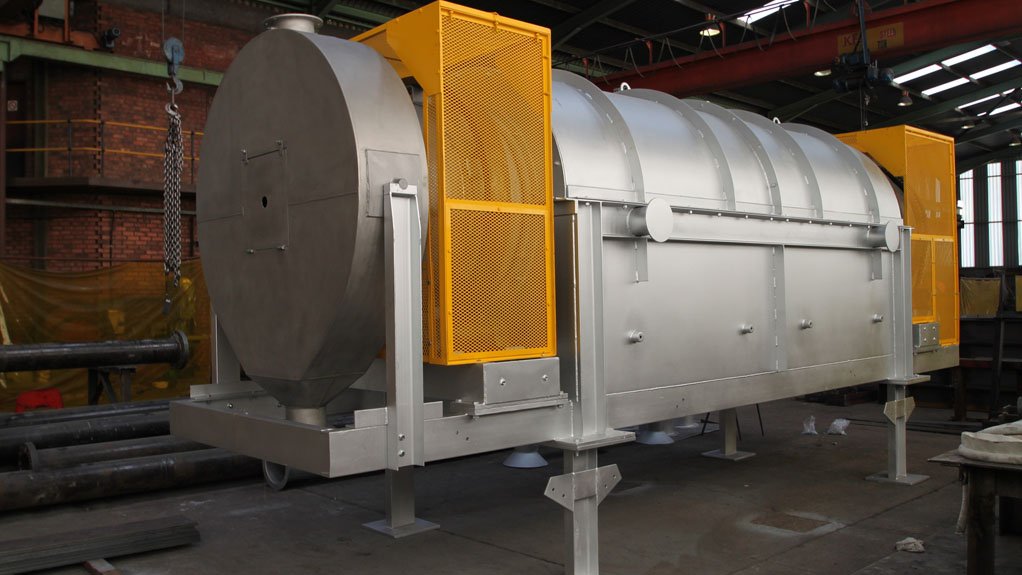
Como Engineers specialist equipment manager Sean Galvin (middle) with employees of Banro’s Twangiza mine, in the Democratic Republic of Congo
New Gold Cobar’s 100 kg/h Custom Furnaces regeneration kiln with Como Engineers integrated modular regeneration package
Working together from across the Indian Ocean for more than 25 years, Custom Furnaces of Randvaal, South Africa, and Como Engineers of Perth, Western Australia, have been combining their respective engineering expertise in the areas of heat treatment and elution and refining to the gold industry since the widespread application of carbon-in-leach (CIL) and carbon-in-pulp (CIP) processes in gold recovery.
Now, Custom Furnaces and Como Engineers join forces in an alliance to strengthen that partnership and provide solutions to the African gold mining industry as a packaged solution for elution, carbon regeneration and gold refining processes.
Custom Furnaces grew out of the Bohler Steel group of companies under the direction of its furnace division head John Lee. Realising the need for regenerative kilns for the developing CIL/CIP mining market, Lee designed and built Bohler’s first rotary carbon treatment kiln in 1981 to investigate the parameters required for optimising carbon regeneration. These process parameters eventually provided the design basis for the first carbon kiln delivered to a mine site that same year. Today, Custom Furnaces products include laboratory and heat treatment and hardening furnaces, as well as rotary kilns for applications such as drying, calcining, metal reduction and roasting.
“Our first test carbon kiln was manually rotated, requiring intense dedication to extract those parameters, but it set us on the correct path for designing a kiln for carbon regeneration that was based, first and foremost, on getting regeneration activities as high as possible – above 90% – as gold CIP depends on its carbon activity to adsorb gold from the leached pulp,” Lee says.
While carbon manufacturers were advocating 20 minutes regeneration throughput time – an assumption that still holds with many engineering companies today – Lee says the initial testwork showed that, in fact, 20 minutes at maximum hold temperature was required for optimal regenerative performance.
“Carbon is a notorious heat insulator. Get the bed thickness in the retort too thick – even at the right hold temperature – and the heat won’t transfer to carbon on the inside of the retort, leading to poor regeneration. The kiln may cost you less, but if the fundamentals just aren’t there in your process, you are doing yourself and your recovery process a disservice,” Lee states.
Also key to good regeneration is lifting and homogenising the carbon with the use of lifters. However, perfecting the attachment of lifters to the retort without causing them to add to distortion of the barrel and leading to premature failure, is all in the design. Lee says many rotary kiln manufacturers stopped using lifters, but Custom Furnaces has found a way of using them without sacrificing retort lifetime, and thereby improving the process.
Like any process, control is key. Custom Furnaces uses screw feeders for its carbon feed, providing a uniform throughput through the kiln. Unlike vibratory feeders, where the product throughput is dependent on the changing characteristics of the feed stock, screw feeders are positive displacement and with variable-speed-drive control can be adjusted during commissioning as a set.
But perhaps the most important parameter in carbon regeneration, Lee says, is the control of the steam atmosphere. Pyrolysis of inorganic contaminants with water and the exclusion of oxygen, which can cause oxidation and burning of the carbon, is paramount. Maintaining a positive pressure in the retort above the carbon and maintaining a reducing atmosphere promote optimal regeneration at 750 ºC. In Custom Furnaces’ designs, this water comes from the water absorbed, which is near equivalent of the carbon processed, which is introduced directly into the kiln.
“This is why predryers don’t work,” Lee says. “The latent heat of vapourisation of water is why the thermal power in the first heat-up zone, within a Custom Furnaces kiln, accounts for near 45% of the energy input to develop that steam reducing atmosphere. The rapid volatilisation of water, from the pores of the carbon, clears the carbon pores. Take that out by dewatering the product with a predryer and the atmosphere isn’t right. The steam flow must be in the same direction as the product flow. If you go for a counter current design then you’re simply re-adsorbing your products of pyrolysis back onto your carbon. Hot carbon doesn’t adsorb, which is why co-current works.”
Lee encountered that exact problem at Mines de Salsigne, in France, in 1988, after a request by the mine to investigate the poor performance of its vertical carbon kiln. The kiln was achieving regeneration activities of between 30% and 40% and it was having a flow-on effect on the adsorption in the CIL process. In a vertical kiln, the pre- drying is taking necessary water from the product, as the resulting bulk steam migration will blow the carbon up and out of the vertical tubes. The steam that migrates upwards carries contaminants, which are reabsorbed in the incoming cold carbon.
“And that was one of our manufactured kilns,” says Como Engineers specialist equipment manager Sean Galvin. “One of our founding partners heard of the removal of our kiln and went to France to investigate. But you can’t argue with technical performance and activities, so after that we stopped manufacturing the vertical kiln and opted for a partnership with Custom Furnaces going forward.”
Como Engineers, which is well known for its modular elution and goldroom plants along with equipment such as electrowinning cells, rectifiers and sludge recovery equipment, has gone from strength to strength over the last 25 years, developing a world-class automated plant capable of eluting from 1 t to over 20 t carbon capacity.
“System performance is our strength,” says Galvin. “Our elution plants are the fastest performing elution and electrowinning equipment available on the market today.”
Como Engineers has delivered automated and manual modular plants around the world, including to Semafo for a mine in Burkina Faso, to Banro’s Twangiza mine, in the Democratic Republic of Congo (DRC), Endeavour Mining’s Tabakoto mine, in Mali, Guemassa and Touit, in Morocco, as well as cells and ancillaries to the likes of Randgold Resources’ Kibali mine, in the DRC, and Morila mine, in Mali.
“We’ve recently developed a large-scale ‘kit plant’ that achieves the requirements of space and ease of maintenance suited to the 10 t to 20 t capacity elution installations with free-standing goldroom buildings, which we’ll be displaying at Electra Mining Africa this year,” Galvin says.
New product developments, including quick replacement Rescal purified resistance material candle heating elements for the Custom electric kilns, will also be on display.
“Like with Custom Furnaces, that performance comes from years of process improvement, innovation and technical expertise that you can’t get from people who haven’t been constantly in that field for the last 25-plus years. We’ve learned from our mistakes, corrected them and we continue developing. “Our new alliance and booth at Electra Mining Africa 2014 takes that combined strength forward and offers that unique combination of products to the African mining market with the backup support to reinforce that commitment,” he states.
Hall 5 Stand F22
Comments
Press Office
Announcements
What's On
Subscribe to improve your user experience...
Option 1 (equivalent of R125 a month):
Receive a weekly copy of Creamer Media's Engineering News & Mining Weekly magazine
(print copy for those in South Africa and e-magazine for those outside of South Africa)
Receive daily email newsletters
Access to full search results
Access archive of magazine back copies
Access to Projects in Progress
Access to ONE Research Report of your choice in PDF format
Option 2 (equivalent of R375 a month):
All benefits from Option 1
PLUS
Access to Creamer Media's Research Channel Africa for ALL Research Reports, in PDF format, on various industrial and mining sectors
including Electricity; Water; Energy Transition; Hydrogen; Roads, Rail and Ports; Coal; Gold; Platinum; Battery Metals; etc.
Already a subscriber?
Forgotten your password?
Receive weekly copy of Creamer Media's Engineering News & Mining Weekly magazine (print copy for those in South Africa and e-magazine for those outside of South Africa)
➕
Recieve daily email newsletters
➕
Access to full search results
➕
Access archive of magazine back copies
➕
Access to Projects in Progress
➕
Access to ONE Research Report of your choice in PDF format
RESEARCH CHANNEL AFRICA
R4500 (equivalent of R375 a month)
SUBSCRIBEAll benefits from Option 1
➕
Access to Creamer Media's Research Channel Africa for ALL Research Reports on various industrial and mining sectors, in PDF format, including on:
Electricity
➕
Water
➕
Energy Transition
➕
Hydrogen
➕
Roads, Rail and Ports
➕
Coal
➕
Gold
➕
Platinum
➕
Battery Metals
➕
etc.
Receive all benefits from Option 1 or Option 2 delivered to numerous people at your company
➕
Multiple User names and Passwords for simultaneous log-ins
➕
Intranet integration access to all in your organisation


